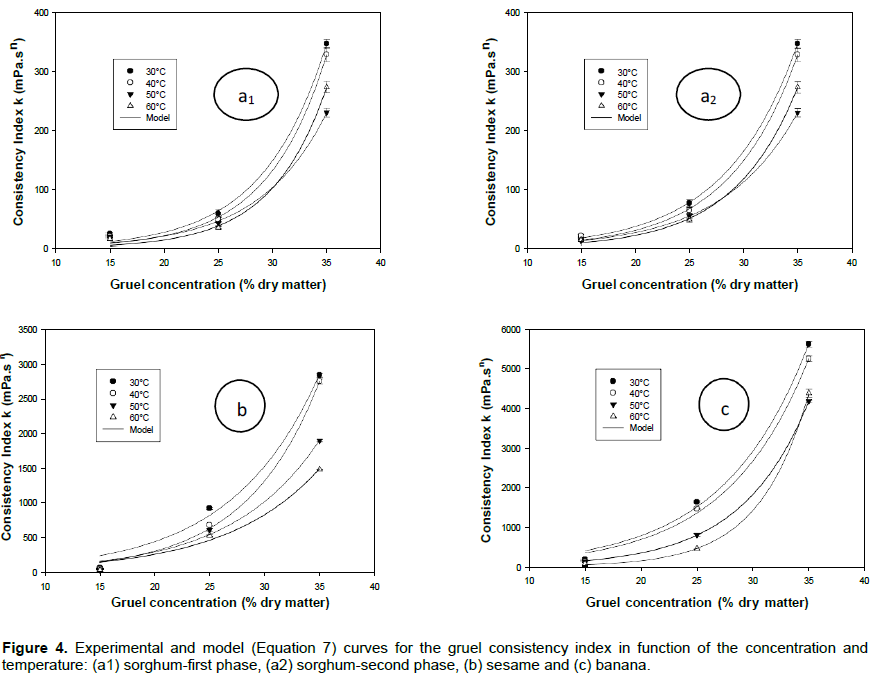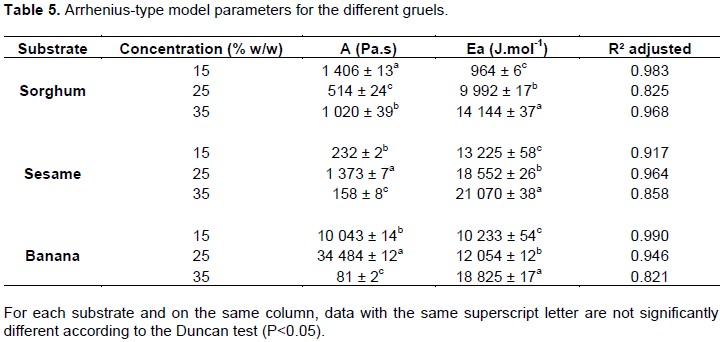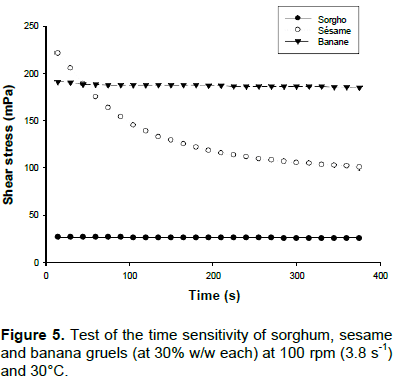Full Length Research Paper
ABSTRACT
This study investigated the flow behaviour of some food gruels obtained from pre-treated banana, sorghum or sesame flours. The Herschel-Bulkley and the power law models were used to evaluate the consistency and flow indices while an Arrhenius-type equation was used to analyse the effect of temperature on viscosity. The Ostwald de Waele model gave a good fit with experimental data, with p-values less than 0.01 and R2 values greater than 0.96 for most of the experiments. The results revealed a pseudoplastic, dilatant and time independent character for the sorghum gruels while the sesame and banana gruels revealed a pseudoplastic and time-dependent character. The effect of temperature on viscosity led to an activation energy and second Arrhenius parameter varying from 964 to 21,070 J.mol-1 and from 81 to 34,484 Pa.s respectively. The concentration dependence of the consistency index was modelled using an exponential equation and showed a decrease with temperature.
Key words: Sorghum gruel, sesame gruel, banana gruel, power law, Arrhenius law, time dependency.
INTRODUCTION
MATERIALS AND METHODS


RESULTS AND DISCUSSION











CONCLUSION
CONFLICT OF INTERESTS
REFERENCES
|
Abbas FMA, Saifullah R, Azhar ME (2009). Assessment of physical properties of ripe banana flour prepared from two varieties: Cavendish and Dream banana. Int. Food Res. J. 16:183-189. |
|
|
Abdelghafor RF, Mustafa AI, Ibrahim AMH, Chen YR, Krishnan PG (2013). Effects of Sorghum Flour Addition on Chemical and Rheological Properties of Hard White Winter Wheat. Adv. J. Food Sci. Technol. 5(11):1407-1412. |
|
|
Abu-Jdayil B (2003). Modelling the time-dependent rheological behaviour of semisolid foodstuffs. J. Food Eng. 57:97–102. |
|
|
AFNOR (Association Française de Normalisation) (1981). Recueil de normes françaises. Corps gras, graines oléagineuses, produits dérivés. AFNOR, Paris (France), 2ème édition. |
|
|
AFNOR (Association Française de Normalisation) (1984). Recueil de normes françaises. Produits agricoles alimentaires : directives générales pour le dosage de l'azote avec minéralisation selon la méthode de Kjedahl. AFNOR, Paris (France). |
|
|
Ahmed J, Ramaswamy HS (2007). Dynamic and steady shear rheology of fruit puree based baby foods. J. Food Sci. Technol. 44(6):579-585. |
|
|
Akbulut M, Saricoban C, Ozcan MM (2012). Determination of Rheological Behavior, Emulsion Stability, Color, and Sensory of Sesame Pastes (Tahin) Blended with Pine Honey. Food Bioprocess Technol. 5:1832-1839. |
|
|
Anonymous (1998). Brookfield DV-III Ultra, Programmable Rheometer, Operating Instructions, Manuel No. M/98-211-C0310; Brookfield Engineering Laboratories Inc, Middleboro (USA). 119 p. |
|
|
AOAC (Association of Official Agricultural Chemists) (1975). Official method of analyses (11th) Washington. D.C.USA. |
|
|
AOAC (Association of Official Agricultural Chemists) (1990).Official methods of analyses. Association of Official Analytical Chemists: Washington, DC. |
|
|
Arslan E, Yener ME, Esin A (2005). Rheological characterization of tahin/pekmez (sesame paste/concentrated grape juice) blends. J. Food Eng. 69:167-172. |
|
|
Aurore G, Parfait B, Fahrasmane L (2009). Bananas, raw materials for making processed food Products. Trends Food Sci. Technol. 20:78-91. |
|
|
Çiftçi D, Kahyaoglu T, Kapucu S, Kaya S (2008). Colloidal stability and rheological properties of sesame paste. J. Food Eng. 87:428-435. CODEX (1989). Codex standard for sorghum grains. Codex STAN 172 -1989, 4 p. |
|
|
Devani MB, Shioshoo J, Shal SA, Suhagia BN (1989). Spectrophotometrical method for micro determination of nitrogen in Kjeldahl digest. J. Ass. Off. Anal. Chem. 72(6):953-956. |
|
|
Elkhalifa AEO, Bernhardt R (2010). Influence of grain germination on functional properties of sorghum flour. Food Chem. 121(2):387–392. |
|
|
Elleuch M, Besbes S, Roiseux O, Blecker C, Attia H (2007). Quality characteristics of sesame seeds and by-products. Food Chem. 103(2):641-650. |
|
|
Elmaki Hagir B, Babiker EE, Abdullahi H El Tinay (1999). Changes in chemical composition, grain malting, starch and tannin contents and protein digestibility during germination of sorghum cultivars. Food Chem. 64:331-336. |
|
|
Eneje LO, Ogu EO, Aloh CU, Odibo FJC, Agu RC, Palmer GH (2004). Effect of steeping and germination time on malting performance of Nigerian white and yellow maize varieties. Process Biochem. 39:1013-1016. |
|
|
FAO (1989). Guide pratique - Stockage et conservation des grains à la ferme : http://www.fao.org/wairdocs/x5163f/x5163f02.htm |
|
|
Fischer EH, Stein EA (1961). DNS colorimetric determination of available carbohydrates in food. Biochemical Preparation 8:30-34. |
|
|
Forster M, Rodríguez ER, Martín JD, Romero CD (2003). Distribution of Nutrients in Edible Banana Pulp. Food Technol. Biotechnol. 41(2):167-171. |
|
|
Gerbouin-Rérolle P (1996). Comment améliorer les aliments de complément du jeune enfant ? Centre International de l'Enfance. 75016 Paris (1996). Tirés à part, dans «Cahiers Santé», 6(4):229-235. |
|
|
Giamarchi P, Trèche S (1995). Fabrication de bouillies de sevrage de haute densité énergétique à base de manioc. Transformation Alimentaire du Manioc. Editions ORSTOM, Laboratoire d'Etudes sur la Nutrition et I'Alimentation (UR44), Centre DGRST-ORSTOM, Brazzaville (Congo). pp. 649-685. |
|
|
Gnahé Dago A, Kunimboa Abro AAK, Gbogouri Grodji A, Brou Kouakou, Gnakri Dago (2009). Rheological and Nutritional Characteristic of Weaning Mush Prepared from Mixed Flours of Taro [Colocasia esculenta (L) Schott], Pigeon Pea (Cajanus cajan) and Malted Maize (Zea mays). Pak. J. Nutr. 8(7):1032-1035. |
|
|
Guerrero SN, Alzamora SM (1997). Effect of pH, Temperature and Glucose Addition on Flow Behaviour of Fruit Purées I. Banana Purée. J. Food Eng. 33:239-256. |
|
|
Habibi-Najafi MB, Alaei Z (2006). Rheological Properties of Date Syrup/Sesame Paste Blend. World J. Dairy Food Sci. 1(1):01-05. |
|
|
Hahm T, Park S, Lo YM (2009). Effects of germination on chemical composition and functional properties of sesame (Sesamum indicum L.) seeds. Bioresour. Technol. 100:1643-1647. |
|
|
Honfo FG, Tenkouano A, Coulibaly O (2011). Banana and plantain-based foods consumption by children and mothers in Cameroon and Southern Nigeria: comparative study. Afr. J. Food Sci. 5(5):287-291. |
|
|
Ikujenlola AV, 2014. Chemical and functional properties of complementary food blends from malted and unmalted acha (Digitaria exilis), soybean (Glycine max) and defatted sesame (Sesamum indicum L.) flours. Afr. J. Food Sci. 8(7):361-367. |
|
|
Jiokap Nono Y, Reynes M, Zakhia N, Raoult-Wack AL, Giroux F (2002). Mise au point d'un procédé combiné de déshydratation imprégnation par immersion et séchage de bananes (Musa acuminata groupe Cavendish). J. Food Eng. 55:231-236. |
|
|
Joshi P, Varma K (2015). Assessment of Nutritional and Physiochemical properties of Banana Flour. Research J. Family, Community Consumer Sci. 3(5):1-3. |
|
|
Laurent F (1998). Comment rendre efficace l'utilisation des bouillies traditionnelles ? La farine MISOLA, en complément de l'allaitement maternel. Malnutrition infantile dans les pays en voie de développement. pp. 1-18. |
|
|
Lokumcu Altay F, Ak MM (2005). Effects of temperature, shear rate and constituents on rheological properties of tahin (sesame paste). J. Sci. Food Agric. 85:105-111. |
|
|
Mahajan H, Gupta M (2015). Nutritional, functional and rheological properties of processed sorghum and ragi grains. Cogent Food & Agriculture, Food Sci. & Technol. 1: 1109495. 9 p. |
|
|
Matalanis AM, Campanella OH, Hamaker BR (2009). Storage retrogradation behavior of sorghum, maize and rice starch pastes related to amylopectin ï¬ne structure. J. Cereal Sci. 50:74-81. |
|
|
MINADER (2012). Direction des enquêtes et des statistiques agricoles, Agristat Cameroun N°16, Annuaire des statistiques du secteur agricole campagne 2007 and 2008. pp. 1-98. |
|
|
Mitschka P (1982). Simple conversion of Brookfield R.V.T. readings into viscosity functions. Rheologica Acta. 21:207-209. |
|
|
Mohamed A, Xu J, Singh M (2010). Yeast leavened banana-bread: Formulation, processing, colour and texture analysis. Food Chem. 118:620-626. |
|
|
Mouquet C, Bruyeron O, Trèche S (1998). Les farines infantiles. Dossier les farines infantiles, Bulletin N°15 du réseau Technologie et Partenariat en Agroalimentaire (TPA). pp. 5-11. |
|
|
Mouquet C, Trèche S (2001). Viscosity of gruels for infants: a comparison of measurement procedures. Int. J. Food Sci. Nutr. 52:389-400. |
|
|
Nwakego Ayo-Omogie H, Ogunsakin R (2013). Assessment of Chemical, Rheological and Sensory Properties of Fermented Maize-Cardaba Banana Complementary Food. Food Nutr. Sci. 4:844-850. |
|
|
Okoye IJ, Ojobor CC (2016). Proximate Composition, Energy Content And Sensory Properties Of Complementary Foods Produced From Blends Of Sorghum And African Yam Bean Flour. International J. Scientific Technol. Research, 5(07):274-277. |
|
|
Onabanjo OO, Akinyemi CO, Agbon CA, (2009). Characteristics of complementary foods produced from sorghum, sesame, carrot and crayfish. J. Nat. Sci. Engr. Tech. 8(1): 71-83. |
|
|
Onyango C, Mutungi C, Unbehend G, Lindhauer MG (2010). Rheological and baking characteristics of batter and bread prepared from pregelatinised cassava starch and sorghum and modiï¬ed using microbial transglutaminase. J. Food Eng. 97:465-470. |
|
|
Onyango C, Mutungi C, Unbehend G, Lindhauer MG (2011). Rheological and textural properties of sorghum-based formulations modiï¬ed with variable amounts of native or pregelatinised cassava starch. Food Sci. Technol. 44:687-693. |
|
|
Purseglove JW (1972). Tropical crops, monocotyledons, London, Longman, 2: 607 p. |
|
|
Razavi Seyed MA, Habibi Najaï¬ Mohammad B, Alaee Zahra (2007). The time independent rheological properties of low fat sesame paste/date syrup blends as a function of fat substitutes and temperature. Food Hydrocoll. 21:198-202. |
|
|
Sanogo M (1994). La Production artisanale des farines infantiles, Expériences et procédés. Les éditions du GRET, Paris (France). pp. 1-80. |
|
|
Sanoussi AF, Dansi A, Bokossa-yaou I, Dansi M, Egounlety M, Sanni LO, Sanni A (2013). Formulation and biochemical characterization of sweet potato (Ipomoea batatas) based infant flours fortified with soybean and sorghum flours. Int. J. Curr. Microbiol. Appl. Sci. 2(7):22-34. |
|
|
Steffe JF (1996). Rheological methods in food process engineering. Freeman Press, United State of America, Second Edition. pp. 1-418. |
|
|
Tizazu S, Urga K, Abuye C, Retta N (2010). Improvement of energy and nutrient density of sorghum-based complementary foods using germination. Afr. J. Food Agric. Nutr. Dev. 10(8):2927-2942. |
|
|
Traoré T, Icard-Vernière C, Mouquet C, Picq C, Traoré AS, Trèche S (2003). Variation de l'activité α-amylasique et des teneurs en certains nutriments et facteurs anti-nutritionnels au cours de la préparation de farines de céréales germées par les dolotières de Ouagadougou. 2ème Atelier international / 2nd International Workshop; Voies alimentaires d'amélioration des situations nutritionnelles-Food-based approaches for a healthy nutrition, Ouagadougou. |
|
|
Trèche S (1995). Techniques pour augmenter la densité énergétique des bouillies. L'alimentation de complément du jeune enfant, Paris : ORSTOM éditions. pp. 122-146. |
|
|
Trèche S, Mouquet-Rivier C (2008). Use of amylases in infant foods. Recent research developments in food biotechnology-Enzymes as additives or Processing Aids. pp. 213-245. |
|
|
Wanjala WG, Onyango A, Makayoto M, Onyango C (2016). Indigenous technical knowledge and formulations of thick (ugali) and thin (uji) porridges consumed in Kenya. Afr. J. Food Sci. 10(12):385-396. |
|
Copyright © 2024 Author(s) retain the copyright of this article.
This article is published under the terms of the Creative Commons Attribution License 4.0